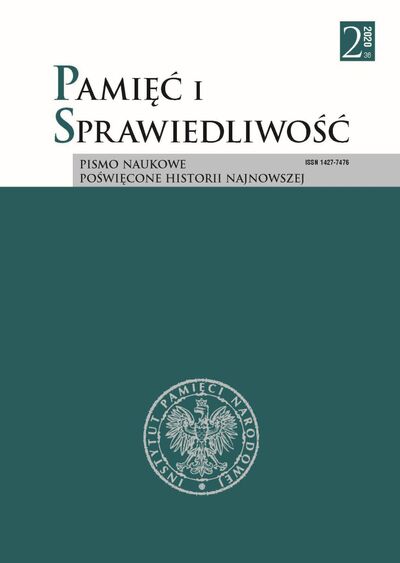The Role of the District Security Threes and Regional Security Fives in Implementing the Hegemony of the Communist Party of Czechoslovakia in the Countryside with the Example of the East Bohemian Regions
Pamięć i Sprawiedliwość, Том 36 № 2 (2020), pages: 169-187
Publication date: 2020-12-31
 https://doi.org/10.48261/PIS203611
https://doi.org/10.48261/PIS203611
Аннотация
This paper focuses on the period 1949–1951, when the district security groups of three (troikas) and the regional security groups of five were active in Czechoslovakia. These groups of leading district and regional apparatchiks were charged with handling of the entire security and criminal agenda that deserved interest “from a political point of view”, and through them there was almost perfect interconnection of the regions with the central authorities of the Communist Party of Czechoslovakia. They were established by a resolution of the security commission of the Central Committee of the Communist Party of 2 February 1949. Their primary task was to control and help the work of security bodies and to resolve personnel issues. In May 1950, their agenda was expanded by a new directive of the Security Commission of the Central Committee of the Communist Party to include other assignments. They were to provide and coordinate cooperation between the party, security organs, local authorities and prosecutors’ offices. The district and regional security groups of three and five were abolished in the autumn of 1951. The paper analyses their role and contribution in securing the hegemony of the Communist Party in the countryside of the East Bohemian regions.
Библиографические ссылки
National Archives, Prague
State District Archive, Hradec Králové
State District Archive, Jičín
State District Archive, Pardubice
State District Archive, Trutnov
State Regional Archive, Zámrsk
Dvořáková J., Státní bezpečnost v letech 1945–1953: (organizační vývoj zpravodajských a státně bezpečnostních složek) (Prague: Úřad dokumentace a vyšetřování zločinů komunismu, 2007).
Dvořáková Z., Z letopisů třetího odboje (Prague: Josef Hříbal, 1992).
Frolík J., “Nástin organizačního vývoje státněbezpečnostních složek SNB v letech 1948–1989”, Sborník archivních prací 1991, vol. 41, no. 2.
Getty J.A., Naumov O.V., The Road to Terror: Stalin and the Self-destruction of the Bolsheviks, 1932–1939 (New Haven: Yale University Press, 1999).
Getty J.A., “Pre-election Fever: The Origins of the 1937 Mass Operations” [in:] The Anatomy of Terror: Political Violence under Stalin, ed. J.R. Harris (Oxford: Oxford University Press, 2013).
Hagenloh P., “ ‘Mass Operations’ under Lenin and Stalin” [in:] The Anatomy of Terror: Political Violence under Stalin, ed. J.R. Harris (Oxford: Oxford University Press, 2013).
Hagenloh P., Stalin’s Police: Public Order and Mass Repression in the USSR, 1926–1941 (Washington: Woodrow Wilson Center Press, 2009).
Jech K., Kolektivizace a vyhánění sedláků z půdy (Prague: Vyšehrad, 2008).
Kaplan K., Kronika komunistického Československa. Klement Gottwald a Rudolf Slánský (Brno: Barrister & Principal, 2009).
Kaplan K., Nebezpečná bezpečnost: Státní bezpečnost 1948–1956 (Brno: Doplněk, 1999).
Kaplan K., Report on the murder of the General Secretary (Columbus: Ohio State University Press, 1990).
Manning R.T., The rise and fall of “the extraordinary measures”, January–June, 1928: Toward a reexamination of the onset of the Stalin revolution (Pittsburgh: Center for Russian and East European Studies, University of Pittsburgh, 2001).
McLoughlin B., “Mass Operations of the NKVD, 1937–8: A Survey” [in:] Stalin’s Terror: High Politics and Mass Repression in the Soviet Union, ed. B. McLoughlin, K. McDermott (Basingstoke: Palgrave Macmillan, 2003).
Petrov N., Roginskii A., “The ‘Polish Operation’ of the NKVD, 1937–8” [in:] Stalin’s Terror: High Politics and Mass Repression in the Soviet Union, ed. B. McLoughlin, K. McDermott (Basingstoke: Palgrave Macmillan, 2003).
Shearer D.R., Chaustov V.N., Stalin and the Lubianka: a Documentary History of the Political Police and Security Organs in the Soviet Union, 1922–1953 (New Haven: Yale University Press, 2015).
Shearer D.R., Policing Stalin’s socialism: repression and social order in the Soviet Union, 1924–1953 (New Haven: Yale University Press, 2009).
Shearer D.R., “Social Disorder, Mass Repression and the NKVD during the 1930s.” [in:] Stalin’s Terror: High Politics and Mass Repression in the Soviet Union, ed. B. McLoughlin, K. McDermott (Basingstoke: Palgrave Macmillan, 2003).
Shearer D.R., “Stalinist Repression, Modernity, and the Social Engineering Argument” [in:] The Anatomy of Terror: Political Violence under Stalin, ed. J.R. Harris (Oxford: Oxford University Press, 2013).
Urban J., “Odpor proti kolektivizaci v Podkrkonoší: JZD, výhrůžky a ozbrojené zastrašování aneb proti politice KSČ jejími vlastními zbraněmi” [in:] Protikomunistický odboj v strednej a východnej Európe, ed. P. Jašek (Bratislava: Ústav pamäti národa, 2012).
Urban J., “Počátky kolektivizace na Královéhradecku ve světle dokumentů centrálních archivů”, Sborník prací východočeských archivů 2009, vol. 13.
Urban J., “Rolnická manifestace: motivace, manipulace, existenční důsledky”, Securitas Imperii 2009, vol. 15.
Urban J., “ ‘V zemědělství je nutno věnovat pozornost všem otázkám’: role bezpečnostních trojek a pětek při prosazování kolektivizace” [in:] Kolektivizace v Československu, ed. J. Rokoský, L. Svoboda (Prague: Institute for the Study of Totalitarian Regimes, 2013).
Urban J., Venkov pod kolektivizační knutou: okolnosti exemplárního “kulackého” procesu (Prague: Vyšehrad, 2010).
Williams K., Deletant, D., Security Intelligence Service in New Democracies: the Czech Republic, Slovakia and Romania (Basingstoke: Palgrave, 2001).
Лицензия
Copyright (c) 2023 Pamięć i Sprawiedliwość

Это произведение доступно по лицензии Creative Commons «Attribution-NonCommercial-NoDerivatives» («Атрибуция — Некоммерческое использование — Без производных произведений») 4.0 Всемирная.
 Język Polski
Język Polski
 English
English
 Deutsch
Deutsch
 Français (France)
Français (France)
 Italiano
Italiano
 Русский
Русский



 PDF (English)
PDF (English)




